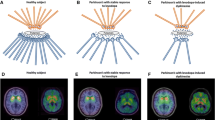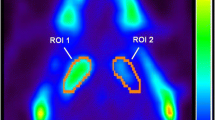Abstract
Purpose
Single-photon emission computed tomography (SPECT) of striatal dopamine transporters (DAT) has been used to demonstrate presynaptic dopaminergic dysfunction and to monitor the progression of Parkinson’s disease. In parkinsonian patients who were implanted with embryonic mesencephalic tissue in the striatum, positron emission tomography (PET) has shown an increase in striatal [18F]dopa uptake as an indicator of graft survival and striatal reinnervation. The aim of this study was to investigate two patients who had undergone bilateral intrastriatal transplantation of human embryonic mesencephalic tissue using SPECT and the 123I-labelled DAT ligand N-(3-iodopropen-2-yl)-2β-carbomethoxy-3β-(4-chlorophenyl) tropane (IPT).
Methods
Two patients were subjected to [123I]IPT SPECT according to a standardised protocol prospectively and repeatedly up to 8 years after transplantation.
Results
From baseline to year 3 after transplantation, mean striatal DAT availability increased by a mean of 61% (93% and 29% in patients 1 and 2, respectively). It then remained relatively stable up to 8 years in patient 2, but increased further by another 77% of baseline values in patient 1. Clinically, both patients experienced a moderate improvement in motor performance but developed moderate (patient 2) to severe (patient 1) off-medication dyskinesias.
Conclusion
Our data indicate that DAT imaging using IPT and SPECT can be used to demonstrate graft survival following dopaminergic tissue implantation. Because SPECT with DAT ligands is widely available in the routine clinical setting, this methodology may be a useful alternative to [18F]dopa PET for repeated scanning of grafted parkinsonian patients. The relevance of the long-term increase in DAT binding for the development of off-medication dyskinesias remains to be elucidated further.
Similar content being viewed by others
References
Bennett DA, Beckett LA, Murray AM, Shannon KM, Goetz CG, Pilgrim DM, et al. Prevalence of parkinsonian signs and associated mortality in a community population of older people. N Engl J Med 1996;334:71–6
Oertel WH, Quinn, N. Parkinsonism. In: Brandt T, Diener HC, Caplan LR, eds. Neurological disorders: course and treatment. San Diego, CA: Academic Press; 1996; p. 715–72
Lang AE, Lozano AM. Parkinson’s disease. Second of two parts. N Engl J Med 1998;339:1130–43
Lang AE, Lozano AM. Parkinson’s disease. First of two parts. N Engl J Med 1998;339:1044–53
Annett L. Functional studies of neural grafts in parkinsonian primates. In: Dunnett SB, Björklund A, eds. Functional neural transplantation. New York: Raven Press; 1994; p. 71–102
Brundin P, Duan WM, Sauer H. Functional effects of mesencephalic dopamine neurons and adrenal chromaffin cells grafted to the rodent striatum. In: Dunnett SB, Björklund A, eds. Functional neural transplantation. New York: Raven Press; 1994; p. 9–46
Lindvall O, Hagell P. Clinical observations after neural transplantation in Parkinson’s disease. Prog Brain Res 2000;127:299–320
Freed CR, Greene PE, Breeze RE, Tsai WY, DuMouchel W, Kao R, et al. Transplantation of embryonic dopamine neurons for severe Parkinson’s disease. N Engl J Med 2001;344:710–9
Olanow CW, Goetz CG, Kordower JH, Stoessl AJ, Sossi V, Brin MF, et al. A double-blind controlled trial of bilateral fetal nigral transplantation in Parkinson’s disease. Ann Neurol 2003;54:403–14
Polgar S, Morris ME, Reilly S, Bilney B, Sanberg PR. Reconstructive neurosurgery for Parkinson’s disease: a systematic review and preliminary meta-analysis. Brain Res Bull 2003;60:1–24
Hagell P, Piccini P, Bjorklund A, Brundin P, Rehncrona S, Widner H, et al. Dyskinesias following neural transplantation in Parkinson’s disease. Nat Neurosci 2002;5:627–8
Brooks DJ. Monitoring neuroprotection and restorative therapies in Parkinson’s disease with PET. J Neural Transm Suppl 2000;60:125–37
Brundin P, Pogarell O, Hagell P, Piccini P, Widner H, Schrag A, et al. Bilateral caudate and putamen grafts of embryonic mesencephalic tissue treated with lazaroids in Parkinson’s disease. Brain 2000;123(Pt 7):1380–90
Kordower JH, Freeman TB, Snow BJ, Vingerhoets FJ, Mufson EJ, Sanberg PR, et al. Neuropathological evidence of graft survival and striatal reinnervation after the transplantation of fetal mesencephalic tissue in a patient with Parkinson’s disease. N Engl J Med 1995;332:1118–24
Chouker M, Tatsch K, Linke R, Pogarell O, Hahn K, Schwarz J. Striatal dopamine transporter binding in early to moderately advanced Parkinson’s disease: monitoring of disease progression over 2 years. Nucl Med Commun 2001;22:721–5
Tatsch K, Schwarz J, Mozley PD, Linke R, Pogarell O, Oertel WH, et al. Relationship between clinical features of Parkinson’s disease and presynaptic dopamine transporter binding assessed with [123I]IPT and single-photon emission tomography. Eur J Nucl Med 1997;24:415–21
Brucke T, Asenbaum S, Pirker W, Djamshidian S, Wenger S, Wober C, et al. Measurement of the dopaminergic degeneration in Parkinson’s disease with [123I]beta-CIT and SPECT. Correlation with clinical findings and comparison with multiple system atrophy and progressive supranuclear palsy. J Neural Transm Suppl 1997;50:9–24
Innis RB, Seibyl JP, Scanley BE, Laruelle M, Abi-Dargham A, Wallace E, et al. Single photon emission computed tomographic imaging demonstrates loss of striatal dopamine transporters in Parkinson disease. Proc Natl Acad Sci U S A. 1993;90:11965–9
Schwarz J, Storch A, Koch W, Pogarell O, Radau PE, Tatsch K. Loss of dopamine transporter binding in Parkinson’s disease follows a single exponential rather than linear decline. J Nucl Med 2004;45:1694–7
Marek K, Innis R, van Dyck C, Fussell B, Early M, Eberly S, et al. [123I]beta-CIT SPECT imaging assessment of the rate of Parkinson’s disease progression. Neurology 2001;57:2089–94
Pirker W, Holler I, Gerschlager W, Asenbaum S, Zettinig G, Brucke T. Measuring the rate of progression of Parkinson’s disease over a 5-year period with beta-CIT SPECT. Mov Disord 2003;18:1266–72
Seibyl J, Jennings D, Tabamo R, Marek K. Neuroimaging trials of Parkinson’s disease progression. J Neurol 2004;251 Suppl 7:vII9–13
Winogrodzka A, Bergmans P, Booij J, van Royen EA, Janssen AG, Wolters EC. [123I]FP-CIT SPECT is a useful method to monitor the rate of dopaminergic degeneration in early-stage Parkinson’s disease. J Neural Transm 2001;108:1011–9
Nurmi E, Ruottinen HM, Bergman J, Haaparanta M, Solin O, Sonninen P, et al. Rate of progression in Parkinson’s disease: a 6-[18F]fluoro-L-dopa PET study. Mov Disord 2001;16:608–15
Morrish PK, Rakshi JS, Bailey DL, Sawle GV, Brooks DJ. Measuring the rate of progression and estimating the preclinical period of Parkinson’s disease with [18F]dopa PET. J Neurol Neurosurg Psychiatry 1998;64:314–9
Lindvall O, Rehncrona S, Brundin P, Gustavii B, Astedt B, Widner H, et al. Human fetal dopamine neurons grafted into the striatum in two patients with severe Parkinson’s disease. A detailed account of methodology and a 6-month follow-up. Arch Neurol 1989;46:615–31
Rehncrona S. A critical review of the current status and possible developments in brain transplantation. Adv Tech Stand Neurosurg 1997;23:3–46
Fahn S, Elton RL. Unified Parkinson’s Disease Rating Scale. In: Fahn S, Marsden CD, Calne D, Goldstein M, eds. Recent developments in Parkinson’s disease. Florham Park, NJ: Macmillan Health Care Information; 1987; p. 153–64
Langston JW, Widner H, Goetz CG, Brooks D, Fahn S, Freeman T, et al. Core assessment program for intracerebral transplantations (CAPIT). Mov Disord 1992;7:2–13
Kordower JH, Freeman TB, Chen EY, Mufson EJ, Sanberg PR, Hauser RA, et al. Fetal nigral grafts survive and mediate clinical benefit in a patient with Parkinson’s disease. Mov Disord 1998;13:383–93
Sperfeld AD, Collatz MB, Baier H, Palmbach M, Storch A, Schwarz J, et al. FTDP-17: an early-onset phenotype with parkinsonism and epileptic seizures caused by a novel mutation. Ann Neurol 1999;46:708–15
Linke R, Gostomzyk J, Hahn K, Tatsch K. [123I]IPT binding to the presynaptic dopamine transporter: variation of intra- and interobserver data evaluation in parkinsonian patients and controls. Eur J Nucl Med 2000;27:1809–12
Thobois S, Jahanshahi M, Pinto S, Frackowiak R, Limousin-Dowsey P. PET and SPECT functional imaging studies in Parkinsonian syndromes: from the lesion to its consequences. Neuroimage 2004;23:1–16
Remy P, Samson Y, Hantraye P, Fontaine A, Defer G, Mangin JF, et al. Clinical correlates of [18F]fluorodopa uptake in five grafted parkinsonian patients. Ann Neurol 1995;38:580–8
Hauser RA, Freeman TB, Snow BJ, Nauert M, Gauger L, Kordower JH, et al. Long-term evaluation of bilateral fetal nigral transplantation in Parkinson disease. Arch Neurol 1999;56:179–87
Ma Y, Feigin A, Dhawan V, Fukuda M, Shi Q, Greene P, et al. Dyskinesia after fetal cell transplantation for parkinsonism: a PET study. Ann Neurol 2002;52:628–34
Piccini P, Brooks DJ, Bjorklund A, Gunn RN, Grasby PM, Rimoldi O, et al. Dopamine release from nigral transplants visualized in vivo in a Parkinson’s patient. Nat Neurosci 1999;2:1137–40
Piccini P, Lindvall O, Bjorklund A, Brundin P, Hagell P, Ceravolo R, et al. Delayed recovery of movement-related cortical function in Parkinson’s disease after striatal dopaminergic grafts. Ann Neurol 2000;48:689–95
Piccini P. Dyskinesias after transplantation in Parkinson’s disease. Lancet Neurol 2002;1:472
Author information
Authors and Affiliations
Corresponding author
Additional information
An editorial commentary on this paper is available at http://dx.doi.org/10.1007/s00259-005-0041-y
Rights and permissions
About this article
Cite this article
Pogarell, O., Koch, W., Gildehaus, F.J. et al. Long-term assessment of striatal dopamine transporters in parkinsonian patients with intrastriatal embryonic mesencephalic grafts. Eur J Nucl Med Mol Imaging 33, 407–411 (2006). https://doi.org/10.1007/s00259-005-0032-z
Received:
Accepted:
Published:
Issue Date:
DOI: https://doi.org/10.1007/s00259-005-0032-z




